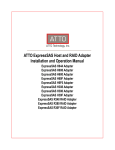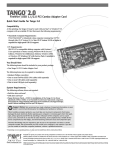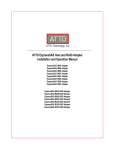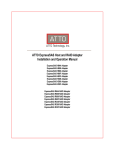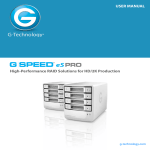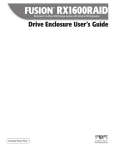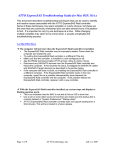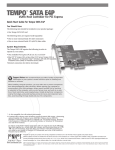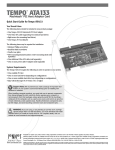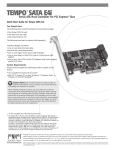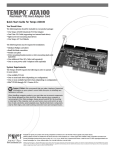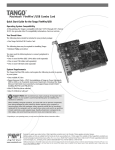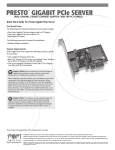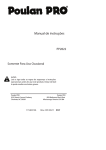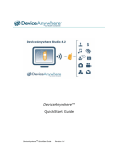Download Installation Manual for Sonnet RAID Controller
Transcript
Installation Manual for Sonnet RAID Controller System Requirements - Mac® Pro and Xserve® Users The Sonnet RAID controller requires the following in order to operate in your system: • One available PCI Express® (PCIe) 2.0 or 1.1 x8 or x16 slot* • Mac OS® X or Mac OS X Server v10.4 or later • Java 1.5 or later System Requirements - Windows® Users The Sonnet RAID controller requires the following in order to operate in your system: • One available PCI Express (PCIe) 2.0 or 1.1 x8 or x16 slot* • Windows 7, Server 2008, Vista®, Server 2003, or XP with SP2 installed • Java 1.5 or later System Requirements - Linux® Users The Sonnet RAID controller requires the following in order to operate in your system: • One available PCI Express (PCIe) 2.0 or 1.1 x8 or x16 slot* • RedHat ES 3, 4; Suse Linux 9, 9.1, 9.2, 9.3, 10, 10.1 and the following architectures: i386 (with or without CONFIG_REGPARM); x86_64 (AMD64, Intel EM64T). • Java 1.5 or later Support Notes: We recommend that you make a backup of important information on your system’s current hard drives prior to installing new hardware or software. When handling computer products, you must take care to prevent components from being damaged by static electricity. Before opening your computer or removing parts from their packages, always ground yourself first by touching a metal part of the computer, such as a port access cover, and work in an area free of static electricity; avoid carpeted areas. Handle all electronic components only by their edges, and avoid touching connector traces and component pins. Also, avoid touching the logic board and any of its components. Support Note: The software on the Installer CD included in the product package may not be the latest version available. Before using this product, check the version numbers of the software on the CD and what’s available at www.sonnettech.com/support/kb/kb.php. Download and install the newer version, if available. * (x4 slot compatible with decreased performance) Remember to register your product online at http://registration.sonnettech.com to be informed of future upgrades and product releases. Software updates and links are available from the Sonnet Website at www.sonnettech.com. • Online support form available at http://supportform.sonnettech.com. Sonnet Technologies Customer Service hours are Mon.-Fri., 7 a.m.–4 p.m. Pacific Time • Customer Service Phone: 1-949-472-2772 • E-mail: [email protected] Sonnet Technologies, Inc., California USA • Tel: 1-949-587-3500 Fax: 1-949-457-6349 ©2010 Sonnet Technologies, Inc. All rights reserved. Sonnet, the Sonnet logotype, Simply Fast, the Simply Fast logotype, and Fusion are trademarks of Sonnet Technologies. Mac, the Mac logo, Mac OS, and Xserve are trademarks of Apple Inc., registered in the United States and other countries. Other product names are trademarks of their respective owners. Product specifications subject to change without notice. Printed in the USA. QS-RAID-HBA2-E-A-092010 Software Installation Steps Mac OS X Driver and Software Installation 16.When the Install Complete window appears, click Done to quit the installer. This section describes the installation of drivers and software to support the Sonnet RAID controller in systems running Mac OS X Version 10.4 and later. 17.Shut down your computer, and proceed to Hardware Installation on page 6. 1. Insert the Sonnet RAID Controller Installer CD into the CD-ROM drive. Double-click the Sonnet RAID CD icon. When the Sonnet RAID x.xx window appears, double-click the Drivers folder. 2. Double-click the ATTOExpressSASRAID2_xxx.pkg icon to launch the installer (xxx is the version). 3. When the Welcome to the ATTO ExpressSAS RAID Driver Installer window appears, click Continue. 4. When the Software License Agreement window appears, read the agreement, click Continue, and then click Agree. 5. When the Standard Install window appears, accept the default location or choose a different one, and then click Install. 6. When asked to do so, enter the Administrator password, and then click OK; the software is installed. 7. When the next window appears, click Restart to restart your system and finish the driver installation. 8. If necessary, double-click the Sonnet RAID CD icon. In the Sonnet RAID x.xx window, double-click the Configuration Tool folder. 9. Double-click the ConfigTool icon to launch the Configuration Tool installer. 10. When asked to do so, enter the Administrator password, and then click OK. 11. When the Introduction window appears, click Next. 12. When the License Agreement window appears, read the agreement, click the I accept the terms of the License Agreement radio button, and then click Next. 13. When the Choose Install Folder window appears, accept the default location or choose a different one, and then click Next. 14. When the Choose Install Set window appears, click the icon next to Full Installation, and then click Next. 15. When the Pre-Installation Summary window appears, click Install; the software is installed. 2 Software Installation Steps Windows 7, Server 2008, and Vista Driver and Software Installation 15. When the Choose Install Folder window appears, either accept the default location or choose a new one, and then click Next. This section describes the installation of drivers to support the Sonnet RAID controller in systems running Windows 7, Server 2008, and Windows Vista. If your system is running Windows Server 2003 or Windows XP, skip to page 4. 16. When the Choose Install Set window appears, click the Full Installation icon, and then click Next. 1. Start Windows and log on as System Administrator. 17. When the Choose Java Virtual Machine window appears, click the radio button next to the Choose a Java VM specifically for this application option, and then click Next. 2. Insert the included software CD. If an Internet Explorer window appears, proceed to the next step. Otherwise, perform one of the following: 18. When the Pre-Installation Summary window appears, click Install. • If an Autoplay window appears, click the Run autorun.bat link to launch Internet Explorer. • If a Windows Explorer window appears displaying the CD-ROM’s contents, double-click the icon for the Autorun batch file to launch Internet Explorer. 19. When the Install Complete window appears, click Done. 20. Back in the browser window, click the Install Windows Utilities link. 3. If a window appears warning about active content, check or uncheck the checkbox per your needs, and then click Yes. Otherwise, skip to the next step. 21. When the File Download - Security Warning window appears, click Run. If you have not disabled User Account Control (UAC), a UAC window will appear; click Continue. 4. In the Internet Explorer window, click the Windows Drivers link in the upper left corner. 5. Click the link for the drivers that apply to your computer. 22. If an Internet Explorer - Security Warning window appears, click Run. Otherwise, go to the next step. 6. Under the Windows Vista heading, click the Install Storport Driver link. 23. When the Welcome to the ATTO HBA Utilities Setup Wizard window appears, click Next. 7. If a File Download - Security Warning window appears, click Run. If you have not disabled User Account Control (UAC), a UAC window will appear; click Continue. 24. When the Select Installation Folder window appears, either accept the default location or choose a new one, and then click Next. 8. When the ATTO Windows Driver Installer window appears, click Install; the driver is installed. 25. When the Confirm Installation window appears, click Next. 26. After the utilities have been installed, an Installation Complete window appears; click Close to exit. 9. After the driver installation is complete, a Setup window will appear with a message stating no adapter was detected; click No to close the window and continue with the software installation. 27.Shut down your computer, and proceed to Hardware Installation on page 6. 10. Back in the browser window click the Windows Applications link on the left. 11. Click the Install Configuration Tool link. 12. If a window appears warning about active content, check or uncheck the checkbox per your needs, and then click Yes. Otherwise, skip to the next step. 13. When the Configuration Tool Introduction window appears, click Next. 14.When the License Agreement window appears, click the radio button next to the option to accept the license agreement, and then click Next. 3 Software Installation Steps Windows Server 2003/Windows XP Driver and Software Installation 16. When the Introduction window appears, click Next. This section describes the installation of drivers to support the Sonnet RAID controller in systems running Windows Server 2003 or Windows XP. 17. When the License Agreement window appears, click the radio button next to the option to accept the license agreement, and then click Next. 1. Start Windows and log on as System Administrator. 18. When the Choose Install Folder window appears, either accept the default location or choose a new one, and then click Next. 2. Insert the included software CD; an Internet Explorer window will appear. 19. When the Choose Install Set window appears, click the Full Installation icon, and then click Next. 3. If a window appears warning about active content, check or uncheck the checkbox per your needs, and then click Yes. 20. When the Choose Java Virtual Machine window appears, click the radio button next to the Choose a Java VM specifically for this application option, and then click Next. 4. Click the Windows Drivers link in the upper left corner. 5. Click the link for the drivers that apply to your computer. 21. When the Pre-Installation Summary window appears, click Install. 6. If you are using a 32-bit version of Windows XP, click the Install SCSIport Driver link under the Windows XP heading. If you are using a 64-bit version of Windows XP, or any version of Windows Server 2003, click the Install Storport Driver link under the appropriate heading. 22. When the Install Complete window appears, click Done. 23. Back in the browser window, click the Install Windows Utilities link. 7. When the File Download - Security Warning window appears, click Run. 24. When the File Download - Security Warning window appears, click Run. 8. When the Internet Explorer - Security Warning window appears, check or uncheck the checkbox per your needs, and then click Run. 25.When the Internet Explorer - Security Warning window appears, click Run. 9.When the ATTO Windows Driver Installer window appears, click Install. 26. When the Welcome to the ATTO HBA Utilities Setup Wizard window appears, click Next. 10.When the Setup window appears, click OK. 27. When the Select Installation Folder window appears, either accept the default location or choose a new one, and then click Next. 11. After the driver installation is complete, a window will appear with a message stating no adapter was detected; click No to close the window and continue with the software installation. 28. When the Confirm Installation window appears, click Next. 29. After the utilities have been installed, an Installation Complete window appears; click Close to exit. 12. Back in the browser window click the Windows Applications link on the left. 30.Shut down your computer, and proceed to Hardware Installation on page 6. 13. Click the Install Configuration Tool link. 14. When the File Download - Security Warning window appears, click Run. 15.When the Internet Explorer - Security Warning window appears, click Run and the installer will launch. 4 Software Installation Steps Linux Driver and Software Installation The Sonnet RAID controller supports Linux operating systems RedHat ES 3, 4; Suse Linux 9, 9.1, 9.2, 9.3, 10, 10.1 and the following architectures: i386 (with or without CONFIG_ REGPARM); x86_64 (AMD64, Intel EM64T). Note: The Sonnet RAID controller is not supported under Linux kernel 2.4. 1.Power on your system, and log in as root. 2.Verify that the kernel header files, usually included with the Linux kernel development package, are installed. 3.Insert the Installation CD, and mount it to your chosen mount point such as /mnt/cdrom. 4.Open your File Browser and browse to /mnt/cdrom/Linux/ Drivers. 5.Click on the driver; the driver filename appears as lnx_drv_ esasraid_XXX.tgz where XXX is the driver’s current version number. 6.Copy the driver file to a directory such as /usr/src. 7.Open a Terminal session, and then change to the directory where you stored the driver. 8.Extract the driver source tar xfz lnx_drv_esasraid_XXX.tgz. 9.Navigate to the lnx_drv_esasraid_XXX directory. 10.Compile and install the driver using ./install.sh; the driver is now installed and ready to use. 11.Add the following line to /etc/modprobe.conf after installing the driver: alias scsi_hostadapterX esasraid where X is the next available adapter number. 12.Shut down your computer, and proceed to Hardware Installation on page 6. 5 Hardware Installation Installation Preparation Sonnet strongly recommends that you read the section in your computer’s user manual that addresses PCI Express card installation, prior to installing the Sonnet card into your system. 1. Figure 1 shows the RAID controller card’s mini-SAS ports, as well as the status LEDs. Installation Steps mini-SAS ports This section covers the installation of the Sonnet RAID controller card into your system. 1. Shut down your computer, and then open it to access the expansion card area (PCI Express slots); refer to your computer’s user manual for specific information. 2. Locate an available x8 (8-lane) or x16 (16-lane) PCI Express slot* inside your computer and remove its access cover. 3. Remove the Sonnet card from its packaging, and then install it into the PCI Express slot; make sure the card is firmly seated and secured. 4. Close your computer. 5. Turn on your computer; depending on the computer and operating system used: • If you installed the card into a Mac Pro (Mid 2010), Mac Pro (Early 2009) or Mac Pro (Early 2008), your installation is complete. • If you installed the card into a pre-2008 Mac Pro, depending on which version of Mac OS X your computer is running, Expansion Slot Utility will open automatically. If it does not open by itself, you must do so manually (Expansion Slot Utility is located in the /System/Library/CoreServices folder). Select the configuration appropriate for your setup (your Sonnet card is an x8 card, and should be assigned to at least an x4 slot), and then click Quit if the default configuration was appropriate, or click Save and Restart if you changed the configuration. Your installation is complete. • If you installed the card into a computer running Windows, various pop-ups will appear during startup as the card is “installed”; your installation is complete. * (x4 slot compatible with decreased performance) 6 Figure 1







